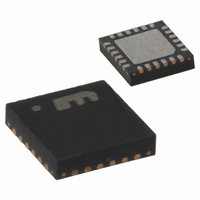MICRF405YML TR Micrel Inc, MICRF405YML TR Datasheet - Page 28

MICRF405YML TR
Manufacturer Part Number
MICRF405YML TR
Description
868-915 MHz ISM Band Transmitter
Manufacturer
Micrel Inc
Datasheet
1.MICRF405YML_TR.pdf
(46 pages)
Specifications of MICRF405YML TR
Frequency
290MHz ~ 980MHz
Applications
ISM
Modulation Or Protocol
ASK, FSK
Data Rate - Maximum
200 kbps
Power - Output
10dBm
Current - Transmitting
18mA
Data Interface
PCB, Surface Mount
Antenna Connector
PCB, Surface Mount
Voltage - Supply
2.2 V ~ 3.6 V
Operating Temperature
-40°C ~ 125°C
Package / Case
24-MLF®, QFN
Operating Temperature (min)
-40C
Operating Temperature (max)
125C
Operating Temperature Classification
Automotive
Product Depth (mm)
4mm
Product Length (mm)
4mm
Operating Supply Voltage (typ)
2.5/3.3V
Operating Supply Voltage (max)
3.6V
Lead Free Status / RoHS Status
Lead free / RoHS Compliant
Features
-
Memory Size
-
Lead Free Status / Rohs Status
Compliant
Other names
576-1965-2
MICRF405YMLTR
MICRF405YMLTR
MICRF405YMLTR
MICRF405YMLTR
April 2006
Divider Modulation Modulation[1:0]=2, modulation
by switching between two sets of dividers, A0/N0/M0
and A1/N1/M1, is selected. In this case, the PLL
needs to settle at the new frequency for each bit-
shift. Therefore, the PLL bandwidth needs to be
sufficiently high enough to follow the modulation.
The PLL bandwidth/bit rate ratio controls the filtering
of the modulation. A large ratio gives little filtering
and a square shape to the data; while a small ratio
gives hard filtering of the data. To avoid large
overshoots, a large phase margin is desired, about
70 degrees will give about 10% overshoot. The
tradeoff is less rejection of the phase detector
frequency.
ASK Modulation is selected when ASK_en=1 and
Modulation[2:0]=3. The ASK modulation depth is
controlled by the ASK[2:0] bits, and is equal to
Micrel
Figure 13. Carrier Drift in Open-Loop Modulation.
-100
-200
-300
-400
-500
-600
-700
100
0
-40
-20
Openloop drift Vdd=3.6V
0
20
Temperature (degC)
40
60
80
100
120
28
{PA[2:0]-ASK[2:0]}*3dB. If PA[2:0]<=ASK[2:0], the
ASK modulation will be On Off Keying (OOK). For
example, PA[2:0]=7 and ASK[2:0]=7 is OOK, but if
ASK[2:0]=4, the modulation depth is –9dB (output
power for “1” is 10dBm and “0” is 1dBm). The
modulation depth is a tradeoff between occupied
bandwidth and sensitivity in the receiver. When
increasing the modulation depth, the pulling effect of
the VCO will also increase and can be seen as FM
components in the transmitted signal. To reject the
pulling of the VCO, shaping can be applied to the
ASK signal. The ASKshape[2:0] bits control the
shaping, where ASKshape[2:0] = 7 gives the most
shaping. The shaping is user selectable but a table
of recommended values is shown in Table 19.
A high PLL bandwidth will also help to avoid pulling
of the VCO. The internal third order loop filter should
be selected.
ASK bitrate (kbps)
Table 19. Recommended ASK Shaping.
< 19.2
< 38.4
< 4.8
< 9.6
< 50
Recommended
ASKshape
7
6
4
2
0
MICRF405
(408) 955-1690
M9999-041906











